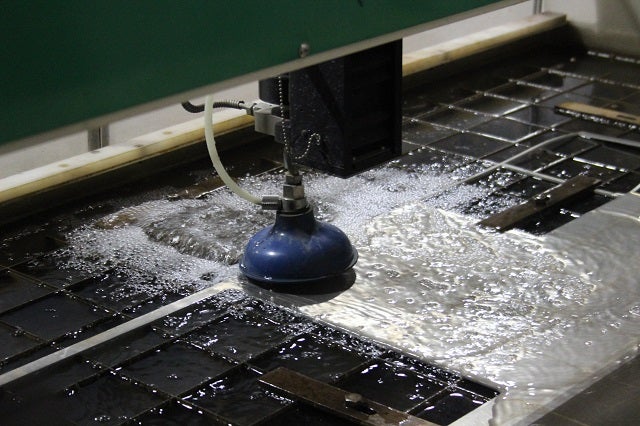
The Cutting Edge of Mishimoto - WARDJet Water Jet Cutter
A Sharper Knife
When early man wanted?to cut something, he beat two rocks together until one of them was vaguely pointy and sharp. I imagine there were probably a lot of smashed thumbs and whatever the equivalent of cursing was to a caveman.? Over thousands of years, humans developed new ways of cutting materials (and themselves). The Egyptians created copper saws, early Europeans learned how to harden iron, and the advent of steel led to stronger, more efficient saws.? Then, in the 1880s, George Clemson perfected the hacksaw, and bike thieves all over the world rejoiced.

Water jet cutters have revolutionized the way we cut almost every material
Fast forward to the 21st century, where we use water and crushed rocks to cut steel up to 6 inches thick.? Welcome to the world of the water jet cutter.? Water jet cutters use a jet of water (who would have guessed?) mixed with crushed garnet, and pressurized up to 60,000 psi to slice and dice through just about anything you put in front of it, including steel, titanium, and glass. This jet is formed by passing water through a tiny orifice in a diamond or a ruby.? This orifice can be as small as 0.5mm, which results in very little material loss where the cut is made, in an area known as the kerf. This type of cutter is extremely efficient and accurate, which makes it great for cutting repeated shapes and parts.
A Faster Horse
Here at Mishimoto, we use our water jet cutter on an almost daily basis for everything from cutting prototype brackets to making templates for intake piping (on our Ford Focus RS and Mustang GT, for example). We even use the water jet to make the tools we need to construct our parts. The water jet cutter saves us a ton of time in prototyping and allows us to easily tweak our designs to make them fit and function even better.

Our engineer, Mike, loads a sheet of aluminum into our WARDJet water jet cutter
Our water jet cutter is a WARDKit produced by WARDJet. (Fun fact: WARD stands for Waterjet Abrasive Recycling Dispenser).? This water jet is particularly cool because WARDJet allowed us to use their shop, choose the size we wanted and build the water jet ourselves.? This thing is like the 427 Cobra kit car of the water jet world.? Much like the 427 Cobra, the WARDJet cutter has more than enough power to get the job done.? The 30,000 to 60,000 psi required to cut through 6 inches of steel is generated by a 30 hp intensifier pump.? This pump uses hydraulic pressure to operate a piston, which squeezes water through a small cylinder.? The smaller cylinder creates an "intensification factor" of about 20, meaning that the 3,000 psi of oil pressure used to operate the piston creates 60,000 psi of water pressure.? Of course, it's in our engineers' nature to make great things better, and the water jet is no exception. To more effectively cool the intensifier pump, our engineer, Jason, built an awesome cooling rig using one of our automotive radiators.? This setup lets us cut longer and make more cuts in a shorter amount of time.? Time is money!
A Closer Cut

Mike uses the WARDJet software to map the cutting path for a bracket
The WARDJet cutter is controlled using a CNC (computer numeric control) system.? This allows us to create digital models of the parts we need, transfer them to the WARDJet system, and map out the cutting path using measured coordinates.? The WARDJet can cut sheets of material up to 5 square feet as it follows our drawings down to +/- 0.003" with a standard error down to +/- 0.001".? You could say it's pretty accurate!
A Wittier Title

The versatility of a water jet is almost unbeatable
The WARDJet water jet cutter is a game-changer in our prototyping process.? What previously took hours of cutting on a band saw or drilling on the drill press can now be done with the click of a button.? The water jet lets us accurately test product fitment and create innovative designs without wasting time and resources, which means we can get your Mishimoto parts to you faster.
Coming Up
Keep an eye out for more equipment profiles!




